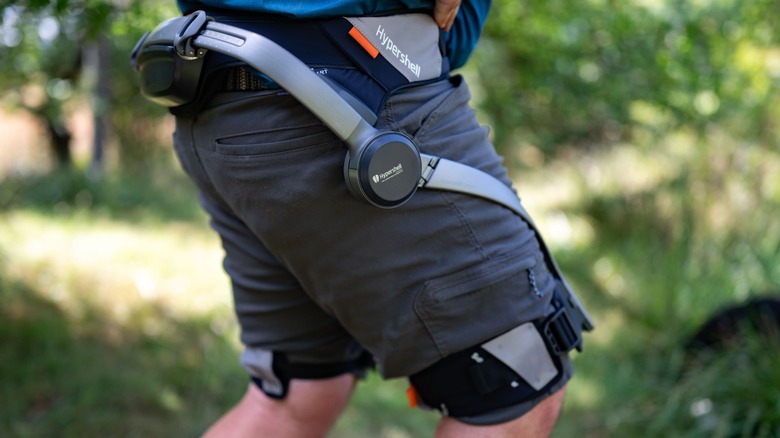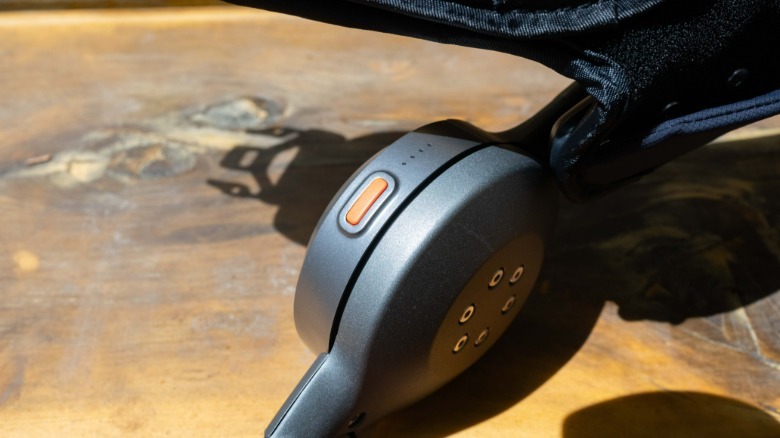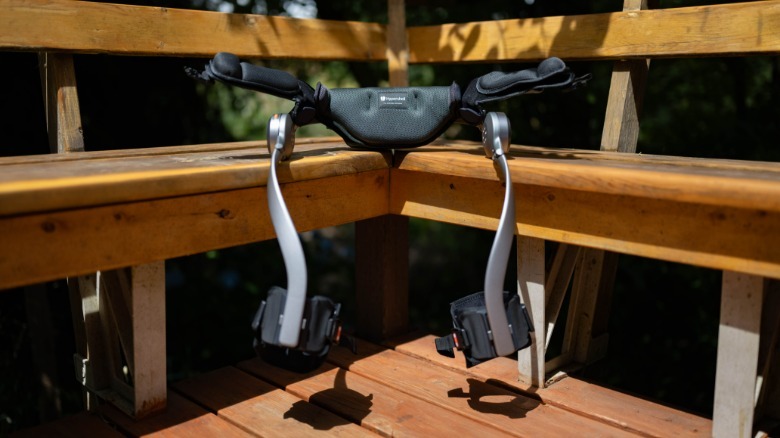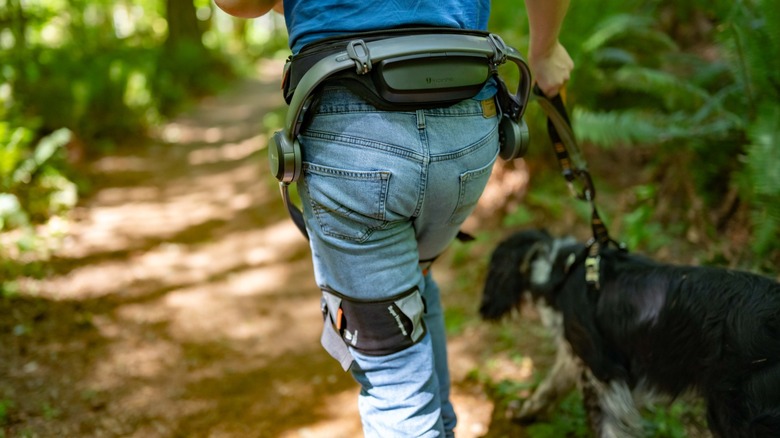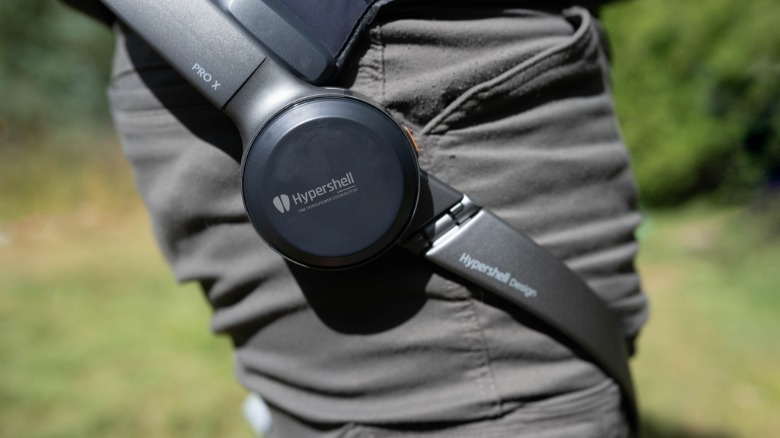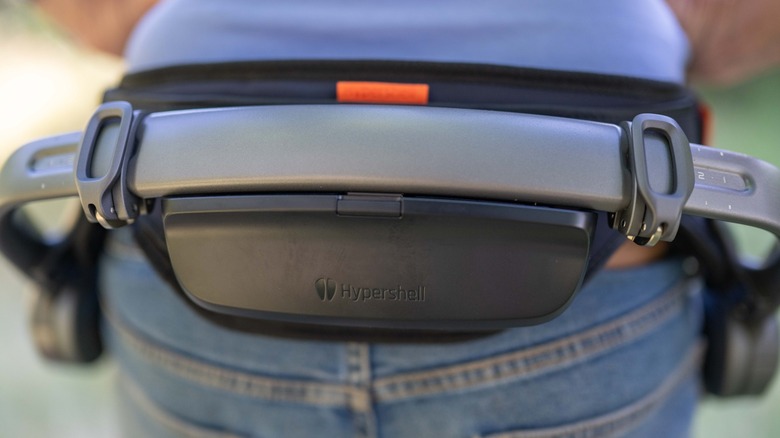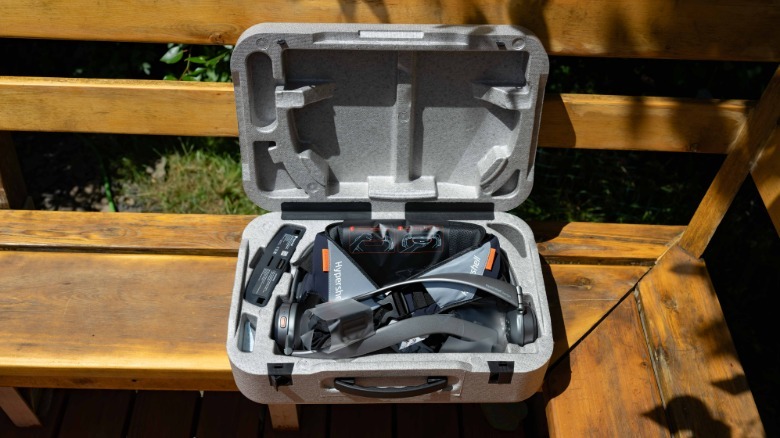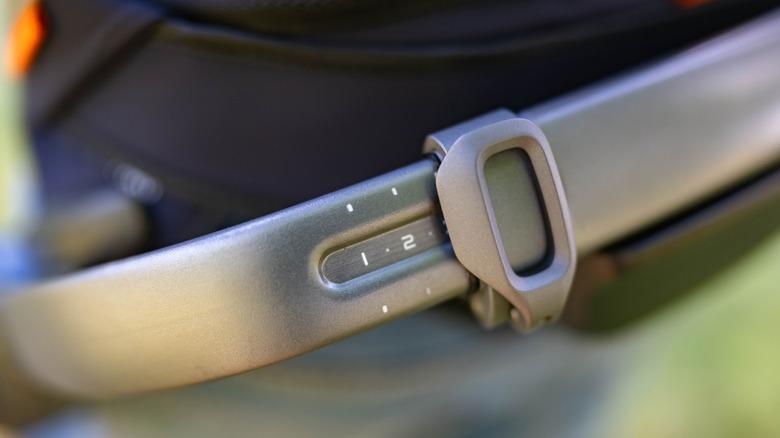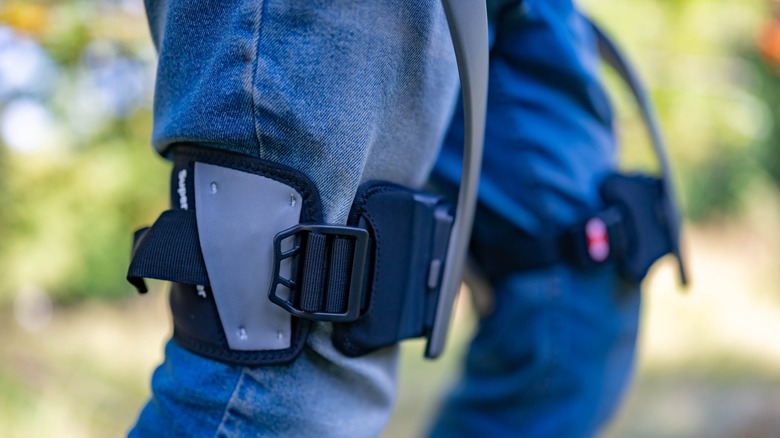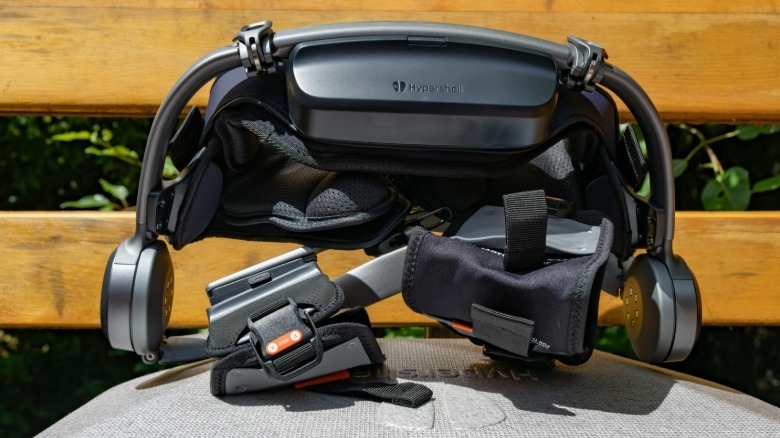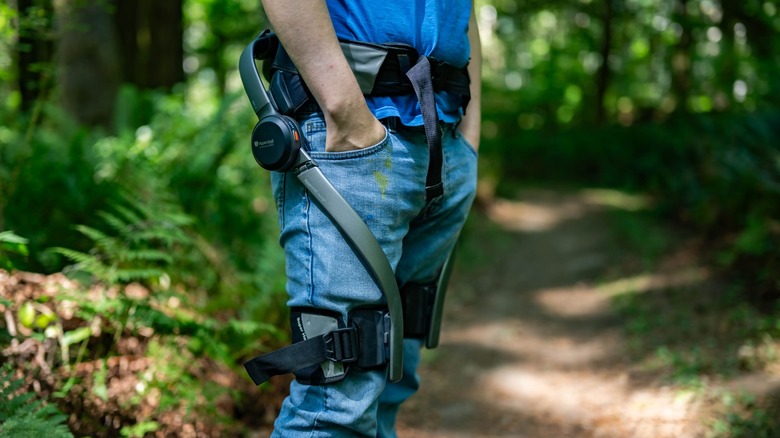Testing Hypershell's Pro X Exoskeleton Is Like Hiking Through A Sci-Fi Movie
The Hypershell Pro X really is like something straight out of science fiction, bringing the concept of a cyborg from the realms of science fiction and experimental military research programs to something which is accessibly priced and readily available to the average consumer. It really wasn't that long ago that exoskeletons were reserved for bugs, films, and dog-eared paperbacks, so to find out such a device now exists and is just something you can go out and buy was shocking.
I'm perhaps somewhat unusual in my desire to one day replace my aging, frail human limbs with robot alternatives, and so there was more than a little bit of wish fulfillment upon receiving the opportunity to test out the Hypershell Pro X (provided by Hypershell for this review). The question I need to answer is whether this is the future which overenthusiastic science mags promised me in my childhood, or if this branch of technology is still in need of a pile of R&D?
Surprisingly easy to use
For such a high tech gizmo, the Hypershell Pro X is strangely one of the simplest gadgets I've tested in terms of user experience. Just download the app, put on the Pro X, power it on, connect it to the app, and you're ready to go. The most complicated part is getting the sizing right, but fundamentally it's just a big belt with two little belts for your thighs. You also need to learn the various button press combinations to turn it on/off and adjust the power, but overall, there's not much to it.
It's honestly amazing how smart the Hypershell Pro X is, with its ability to anticipate your movement and render assistance. Its best trick might be that it just works the vast majority of the time. When I got it fitted right, it was sometimes easy to almost forget I was wearing an exoskeleton. Of note is that I was able to fairly easily share the Hypershell Pro X with friends and family who were curious to try it out, demonstrating how straightforward the adjustment and fitting process is.
Durable, but vulnerable to cosmetic damage
While I tested the Hypershell Pro X during a drought when there wasn't a drop of moisture, the exoskeleton does boast an IP54 rating, so it should survive in relatively damp conditions. I certainly put its dust resistance to the test, as during my backpacking trip with the Hypershell Pro X I encountered lots of very fine dust. This didn't seem to negatively impact the functionality of the Hypershell Pro X, though I did need to clean the USB-C port out afterward.
However, if you do want to wear a pack with the Hypershell Pro X, be prepared to suffer some cosmetic wear and tear to the paint job. I'm sure the fact that I was carrying a particularly large and heavy pack didn't help, but really any pack that extends to your lower back is going to cause friction on the surface of the Hypershell Pro X. If you want to use the Hypershell Pro X with such a low hanging backpack, I'd recommend placing some sort of barrier between the pack and the exoskeleton, perhaps a soft cloth, or some sort of tape which won't leave residue behind.
I would really like to see Hypershell partner with a vinyl skin company to produce stick-on skins for their exoskeletons, to prevent cosmetic wear-and-tear. A silicon plug for the USB-C port would also be a smart thing to include with the product.
Variable, but overall impressive performance
Though I had no way of precisely verifying the claim, my experience with the Hypershell Pro X has confirmed to my satisfaction that under ideal conditions it does indeed deliver on its claim to reduce weight load by 30kg and improve leg strength by 40%. When properly fitted, it is exhilarating to walk on most terrain while wearing the Hypershell Pro X. It really does feel as if you've suddenly gained a considerable amount of muscle in your legs.
Beyond simple walks, I tested the Pro X in unusual and extreme scenarios, most notable of which being a 10 mile backpacking trip in the mountains. On this trip I carried an especially heavy pack with a bunch of extra camera gear, in the hopes that the Pro X would make this excessive burden more bearable. As a result, I found that my legs never got really tired as they normally would have while carrying such a pack without an exoskeleton. However, that didn't spare the rest of my body from the pain and suffering of carrying 80+ pounds up a mountain, so I still ended up exhausted by the time we reached our campsite — except for my legs, which felt strangely energetic by comparison.
I will say also that I did experience some strange muscle aches after the trip in my legs, likely from the way the Hypershell encourages you to take higher steps than my normal slothful shuffle. This might potentially represent a long term health benefit. One thing that impressed me was just how well it handles rough terrain, so that I didn't need to fear it flinging me off a cliff on rugged, exposed portions of trail (though I did put it on standby for one particularly hairy scramble).
Battery life is dependent on how you manage it
The range of the Hypershell Pro X is very much a variable factor based on how you use it. You can see as much as 17.5 kilometers (10.874 miles) on a single charge, according to Hypershell, but that's only if you keep it on lower power settings. The more juice you squeeze out of it, the more limited your range will be. I made it around 5 miles (8km) at 70% power uphill with a heavy pack, so I was glad I had packed a second battery (included with the Pro X) for the trip back down. Of course, carrying an extra battery does cut into the efficacy of the Hypershell, so whether or not to bring the spare battery with you is a careful case-by-case decision.
Unless you're pushing it to the extreme or covering 20 or more miles in a single trip, I don't think you're likely to be limited by battery life with this exoskeleton. The range of the Hypershell is ideal for applications such as dayhiking, photography, and other such activities where you just want to get out and about and do something, while not getting as tired or being able to go farther than you otherwise might.
It's should also be pointed out that the Hypershell Pro X is a bit heavy and large. While you don't really notice this while wearing it, it does make the device somewhat awkward to carry and to store. The included carrying case is very nice, but it's very difficult to properly fold and place the Hypershell in the case so that it will close and latch. In fact, I ended up not using the case at all due to this issue, which is a shame.
Biking, exercise, and potential therapeutic applications
The Hypershell isn't necessarily just for walking and running, it can also be used while riding a bike, though this mode is marked as experimental, and I found it to be less effective and consistent than with travel on foot. It does certainly lend a hand, and I can see the potential for the Hypershell to act essentially like pedal assist on an electric bike, but it seems as though there's some work that's needed on the software side to realize the full potential here.
There's also an experimental exercise mode, which makes the Hypershell resist your movements, causing you to do more work. This could be a great tool for fitness training, particularly if you're looking to build muscle in the areas of the body most affected by the Hypershell.
While Hypershell doesn't advertise it, and I have no medical qualifications with which to speak on the topic, I can certainly see the therapeutic potential of the Hypershell Pro X. The fact that it takes weight off your legs while walking seems like something that could aid folks with limited mobility from a variety of conditions. At the very least, if you're just out of shape, the Hypershell might well help get you started on the path to a healthier lifestyle.
Pricey, but potentially worth it
Hypershell's products don't come cheap, with the Pro X I tested coming in at $1199 via the Hypershell store online, the cheaper, less powerful Go X at $999, and the high end Hypershell Carbon X at $1799. As the name implies, the Carbon X is made with carbon fiber, but also with a 3D-formed titanium alloy in addition to aluminum, making it lighter and more durable.
The Pro X is carbon fiber reinforced – otherwise it is composed of aluminum and stainless steel. By contrast, the Go X uses a reinforced polymer in addition to aluminum and steel. If you can swing the money for it, the X Carbon is the one I'd go for given the additional durability, though the Pro X is reasonably durable if the high price of the X Carbon is too much. Given that the Go X is just a few hundred less than the Pro X, and that you're giving up a lot for that slightly lower price point, I would definitely recommend the Pro X over the Go X.
As for competition, DNSYS also produces a similar product to Hypershell, called the X1, at around the same price point. It appears to be very close in terms of its specs, perhaps slightly better in some regards, but of course I have not had a chance to test it out myself to verify those claims. Also, the DNSYS X1 product appears to have a number of unhoused cables, whereas such components are neatly tucked away in the Hypershell. It's worth noting that DNSYS is also running a Kickstarter for a bizarre sort of knee exoskeleton. That might be better for carrying a large pack, but this is a crowdfunding project, so all bets are off with such a product until it actually hits the market.
Conclusion
I very much enjoyed testing the Hypershell Pro X, and with a few caveats, it absolutely does what it says on the tin. It's amazing how smart it is in how it adapts and moves with you, boosting your strength and lightening your load. For anyone who just needs a little extra strength to get out and go places on foot, it'll get the job done. The feeling of having extra energy while wearing it is subtle, yet at the same time invigorating. It's a device which can certainly push you to travel farther carrying more weight than you might otherwise feel comfortable doing, and is a potentially excellent fitness device for those who need a bit of help getting back in shape.
It is quite an expensive device, because while it's amazing that such an advanced sci-fi-esque device can be sold at a level where it is attainable by average consumers, it is still a considerable amount of money. I also wish it was more compatible with large packs, and in fact what I'd love to see is a version of the Hypershell Pro X integrated into a high capacity backpack. If Hypershell and Gregory Mountain Products could get together and collaborate to combine the Hypershell Pro X with Gregory's Baltoro packs, then I would be a very happy camper indeed.
The Hypershell Pro X is the sort of product that if you see the pitch and think "I could use that," then there's a good chance it will work for you. The Hypershell Pro X is available for $1199 from Hypershell's online store.
